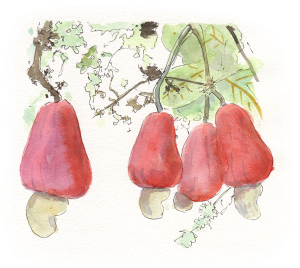URUSHIOL and RASHES

ISSN-1059-6518
URUSHIOL and RASHES
By Frank Hubbell, DO
Illustrations By T.B.R. Walsh
What do cashews, mangos, and pistachios have in common with poison ivy? As unbelievable as it seems, they share one very unpleasant secret: urushiol.
Most everyone loves cashew nuts, considering them a tasty treat. Recently we were in Costa Rica, and as we were heading for a National Park, the driver of our tour bus stopped by the side of the road to pick a funny-looking, pear-shaped, bright red fruit from a tree. After he gave the fruit to us to exam, he explained that it was a cashew apple and attached to the bottom of it was a single cashew nut, referred to as drupe. He then related that the cashew was a member of the poison ivy family and was, which quite toxic.
What’s up with that?
As it turns out cashews, mangos, pistachios, ginko bilboa, poison ivy, poison oak, and poison sumac all belong to the same plant family Anacardiaceae. What these plants all have in common is that they contain the toxin urushiol.
Urushiol is an oily organic allergen that is well known for causing the classic red, itchy poison ivy rash.
Urushiol Facts: This is one amazing toxin!
– Only 1 nanogram (one billionth of a gram) of the urushiol will cause the rash.
– An average of 100 nanograms of the urushiol will cause a rash in 90% of people.
– ¼ ounce of urushiol is all that is needed to cause a rash on every person on earth.
– The amount of urushiol that would fit on the head of a pin will cause a rash on 500 people.
– Urushiol will remain active for 1 – 5 years on surfaces, in clothing, and on plants that have died. This explains why people can get poison ivy rashes in the middle of the winter when the plants are dormant or gone.
